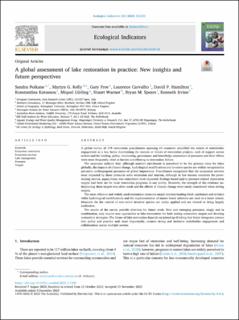| dc.description.abstract | A global survey of 179 restoration practitioners spanning 65 countries identified the extent of stakeholder engagement as a key factor determining the success or failure of restoration projects. Lack of support across sectors and for funding, policy, monitoring, governance and knowledge assessment of pressures and their effects were most frequently cited as factors contributing to restoration failure. The responses indicate that, although nutrient enrichment is perceived to be the primary issue for lakes globally, the impacts of climate change, hydrological modifications and invasive species are widely recognized as pervasive anthropogenic pressures of global importance. Practitioners recognized that the ecosystem services most impacted by these pressures were recreation and tourism, although in low income countries the provisioning service, aquaculture, was considered most impacted. Ecology-based and/or pressure-related restoration targets had been set for most restoration programs in our survey. However, the strength of the evidence underpinning these targets was often weak and the effects of climate change were rarely considered when setting targets. The most effective and widely used restoration measures target nutrient loading (both catchment and in-lake) while hydrological modifications and the implementation of nature-based solutions are used to a lesser extent. Measures for the control of non-native invasive species are rarely applied and are viewed as being largely ineffective. The results of the survey provide direction for future work. New and emerging pressures, singly and in combination, may require new approaches to lake restoration: for both setting restoration targets and devising restoration strategies. The future of lake restoration depends on joined-up thinking that better integrates science into policy and practice and, most importantly, ensures strong and inclusive stakeholder engagement and collaboration across multiple sectors. | en_US |

